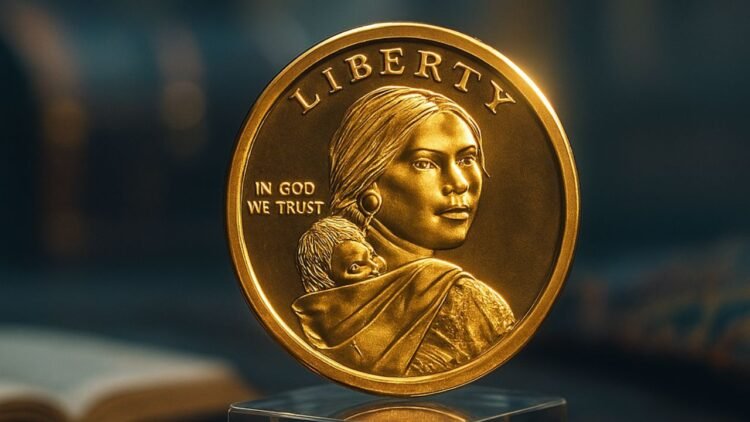The Sacagawea Golden Dollar may only have a face value of one dollar, but its legacy and collectible value continue to capture attention in 2025.
Known for its golden appearance, historical significance, and unique varieties, the Sacagawea Dollar remains a favorite among coin collectors and a symbol of cultural heritage. Whether you’re holding a circulated coin or a rare error variety, this golden dollar proves it is more than just pocket change.
What Is the Sacagawea Golden Dollar?
Introduced in 2000 by the U.S. Mint, the Sacagawea Dollar was designed to replace the Susan B. Anthony dollar.
- Obverse (front): Features Sacagawea, the Shoshone woman who guided Lewis and Clark, carrying her infant son Jean Baptiste.
- Reverse (back): Originally featured a soaring bald eagle. Since 2009, designs change annually to honor Native American history.
- Composition: 88.5% copper, 6% zinc, 3.5% manganese, 2% nickel. It looks golden but contains no real gold.
Its durability and artistry make it stand out from other modern U.S. coins.
History and Origin of the Coin
The U.S. Mint launched the Sacagawea Dollar in 2000, minting over 1 billion coins in the first year. However, public use was limited as Americans continued preferring paper dollars.
From 2002 onward, Sacagawea Dollars were struck mainly for collectors. In 2009, under the Native American $1 Coin Act, the reverse design began changing annually, keeping interest alive among numismatists.
Why the Sacagawea Dollar Still Matters in 2025
The Sacagawea Dollar holds value for three main reasons:
- Cultural Legacy: It honors an Indigenous woman whose role in American history is vital.
- Numismatic Value: Error coins and special varieties can be worth hundreds or thousands of dollars.
- Collector Appeal: With annual design changes, the series remains dynamic and collectible.
Collectible Varieties and Values
While most Sacagawea Dollars are worth face value, some rare varieties sell for much more.
1. Rare Sacagawea Dollar Varieties
| Variety | Description | Approx. Value (MS65) |
|---|---|---|
| 2000-P “Cheerios” | Promo coin with enhanced eagle feathers | $2,000–$5,000 |
| Wounded Eagle | Die crack through eagle’s chest | $100–$500 |
| Mule Error | Sacagawea obverse with Washington quarter reverse | $50,000+ |
| Overstruck | Minted over another coin | Up to $32,000 |
These varieties make ordinary pocket change potentially valuable treasures.
Timeline of the Sacagawea Dollar
| Year | Key Event | Mintage |
|---|---|---|
| 2000 | First release; over 1 billion coins struck | 1,000M+ |
| 2002 | Shift to collector-only issues | 3–5M annually |
| 2009 | Native American reverse designs begin | Varies |
| 2025 | Still produced in low numbers for sets | Low |
How to Start Collecting Sacagawea Dollars
Starting a Sacagawea collection is affordable and exciting.
- Check your change: Rare coins occasionally turn up in circulation.
- Buy rolls or sets: Banks and the U.S. Mint offer collectible rolls.
- Attend coin shows: Dealers and auctions often feature rare Sacagawea varieties.
- Use protective holders: Preserve condition for maximum value.
- Join numismatic forums: Learn from experts and share finds.
High-grade coins (MS67 and above) and error varieties often hold the most value.
Interesting Facts About Sacagawea Coins
- Over 1 billion struck in 2000, but most sit in vaults unused.
- The 2000-P Cheerios Dollar was distributed in cereal boxes as a promotion.
- A mule error coin combining the Sacagawea obverse with a Washington quarter reverse sold for over $100,000 at auction.
The Sacagawea Golden Dollar is more than a simple U.S. coin—it’s a blend of history, culture, and collectible intrigue. While most are worth just $1, rare editions and error coins can command thousands, making it a fascinating target for collectors.
In 2025, the coin continues to symbolize American diversity and heritage, while offering exciting opportunities for numismatists to uncover hidden treasures in their change.
FAQs
Are Sacagawea Golden Dollars made of real gold?
No, they are made from a copper-brass alloy that gives them a golden color.
Which Sacagawea Dollar is the most valuable?
The mule error coin (with a quarter reverse) can sell for $50,000 or more.
Are Sacagawea Dollars still being minted?
Yes, but mainly for collectors, with changing Native American reverse designs each year.

